 |
The earth core is like a nuclear reactor and releases heat by decomposing radioactive elements such as uranium, thorium, and potassium. Scientists have been able to control this heat as early as decades ago - providing energy to turbines through geothermal wells. But now, researchers not only have the ability to drill inside the volcano, but also develop the heat contained in the lava to obtain higher energy. If all existing geothermal wells are replaced with new technologies, the total amount of renewable energy available to people will increase by 30%.
The idea that scientists are trying to develop the energy contained in magma comes from 2 accidents. The first "accident" occurred in 1985. A team of workers who drilled geothermal wells in Iceland encountered an explosion caused by high-pressure steam. The explosion was very sudden and difficult to control. Scientists believe that this high-pressure steam originates from an aquifer where the pressure is so high that the water starts to boil, but the water cannot fully expand and turn into water vapor, so it only has to stay in a liquid state when it reaches 222 atmospheres and temperature. At 374°C or above, water will reach this "supercritical state," and water in this state contains extremely strong energy. As soon as the pressure drops, the water jets out.
Wilfred Elder, professor of geology and professor emeritus at the University of California, Riverside, said: “We hope to develop and use this energy. An ordinary geothermal well can produce 5 to 10 megawatts of electricity, and the energy generated by the supercritical geothermal wells. It will reach 10 times the former."
The second "accident" occurred in 2009 when the Iceland Deep Drilling Project (IDDP) inadvertently sneaked into magma during the drillable theory of a "supercritical fluid well" that melted the drilling equipment. However, the drilling team realized that the intense thermal energy can increase the drilling productivity. The higher the temperature, the easier it is for the water to enter the “supercritical state†and the magma poured into the well exceeds 900°C.
To use lava to produce energy, workers do not need to drill directly on lava. Instead, they can drill wells near low temperatures in lava and then use steam to power the turbines; they can also artificially generate steam through water injection. Although the use of “supercritical geothermal wells†was constrained by geographical factors and heat-resistant materials, the researchers succeeded in drilling above lava in 2011. Although the temperature was only 500°C, its power capacity still reached 35 MW. This is also the first time that researchers have demonstrated that it is feasible to construct a “supercritical geothermal well†with lava “encouragingâ€.
Bruce Marsh, a professor of Earth and Planetary Sciences at Johns Hopkins University who was not involved in the study, said he is optimistic about the enormous scientific value of geothermal wells. Marsh pointed out that magma is a very challenging research area.
Shear Beam Load Cells are widely used where operators need to measure compressive forces. The core component of a shear beam load cell is a spring element. This element is a piece of metal that is elastically deformed under load and recovers the moment the load is removed.
The (single-ended) shear beam is designed for low profile scale and process applications. The shear beam capacities are from 100kg to 50t. One end of the shear beam contains the mounting holes while the opposite end is where the cell is loaded. The load cell should be mounted on a flat smooth surface with high-strength hardened bolts. The larger shear beam cells have more than two mounting holes to accommodate extra bolts to keep the hardware from stretching under stress load.
Shear beams are available of nickel-plated alloy steel or stainless steel for use in harsh environments.Load Cell Central,Shear Beam Load Cells,Larger Shear Beam Cells,Load Cell Measure Compressive Forces
Zhejiang Nanhua Electronic Technology Co., Ltd , https://www.nhloadcell.com
